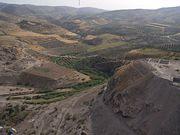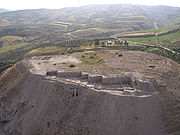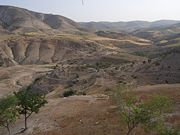
Gadara Region Project
Encyclopedia






History
In 2001, the Gadara Region Project was initiated by Dieter ViewegerDieter Vieweger
Dieter Vieweger, a German Biblical scholar and Prehistorian Archaeologist, was born in Chemnitz, East Germany in 1958.He studied Theology and Prehistoric Archaeology in Leipzig and Frankfurt on Main...
of the Biblical Archaeological Institute
Biblical Archaeological Institute
The Biblical Archaeological Institute Wuppertal was established in 1999 by the Protestant Church of the Rhineland.It constitutes an institute of the “Protestant University of Wuppertal” as well as an associated institute of the University of Wuppertal and holds the right to award doctorates at...
(BAI) of the University of Wuppertal
Wuppertal
Wuppertal is a city in North Rhine-Westphalia, Germany. It is located in and around the Wupper river valley, and is situated east of the city of Düsseldorf and south of the Ruhr area. With a population of approximately 350,000, it is the largest city in the Bergisches Land...
(Germany
Germany
Germany , officially the Federal Republic of Germany , is a federal parliamentary republic in Europe. The country consists of 16 states while the capital and largest city is Berlin. Germany covers an area of 357,021 km2 and has a largely temperate seasonal climate...
). This project has focused on the interdisciplinary investigation of the Wadi al-'Arab south-west of Gadara and the excavation of its most prominent site, Tall Zira'a
Tall Zira'a
The Tall Zira'a is one of the most promising talls of Palestine. Surveys and geophysical investigations showed the site’s great potential for excavations...
. The project has been a joint enterprise of the BAI and the German Protestant Institute of Archaeology (GPIA) in Amman
Amman
Amman is the capital of Jordan. It is the country's political, cultural and commercial centre and one of the oldest continuously inhabited cities in the world. The Greater Amman area has a population of 2,842,629 as of 2010. The population of Amman is expected to jump from 2.8 million to almost...
since 2004, and the Jerusalem branch of same institute entered the project in 2006. It is jointly directed by Dieter Vieweger
Dieter Vieweger
Dieter Vieweger, a German Biblical scholar and Prehistorian Archaeologist, was born in Chemnitz, East Germany in 1958.He studied Theology and Prehistoric Archaeology in Leipzig and Frankfurt on Main...
and Jutta Häser.
Central settlement
Tall Zira'aTall Zira'a
The Tall Zira'a is one of the most promising talls of Palestine. Surveys and geophysical investigations showed the site’s great potential for excavations...
offers the unique possibility of excavating a stratigraphical sequence from the Early Bronze Age (3200 BCE) to 1900 AD in northern Jordan
Jordan
Jordan , officially the Hashemite Kingdom of Jordan , Al-Mamlaka al-Urduniyya al-Hashemiyya) is a kingdom on the East Bank of the River Jordan. The country borders Saudi Arabia to the east and south-east, Iraq to the north-east, Syria to the north and the West Bank and Israel to the west, sharing...
. For the Bronze and Iron Age
Iron Age
The Iron Age is the archaeological period generally occurring after the Bronze Age, marked by the prevalent use of iron. The early period of the age is characterized by the widespread use of iron or steel. The adoption of such material coincided with other changes in society, including differing...
s, the outstanding finds show exemplarily the cultural influences and changes in a contact zone between the historical 'global players' Egypt
Egypt
Egypt , officially the Arab Republic of Egypt, Arabic: , is a country mainly in North Africa, with the Sinai Peninsula forming a land bridge in Southwest Asia. Egypt is thus a transcontinental country, and a major power in Africa, the Mediterranean Basin, the Middle East and the Muslim world...
, Syria
Syria
Syria , officially the Syrian Arab Republic , is a country in Western Asia, bordering Lebanon and the Mediterranean Sea to the West, Turkey to the north, Iraq to the east, Jordan to the south, and Israel to the southwest....
, and Mesopotamia
Mesopotamia
Mesopotamia is a toponym for the area of the Tigris–Euphrates river system, largely corresponding to modern-day Iraq, northeastern Syria, southeastern Turkey and southwestern Iran.Widely considered to be the cradle of civilization, Bronze Age Mesopotamia included Sumer and the...
.
Aims
This project has several main objectives. To fulfill them will mean conducting work and research in the area for an extended period of time.1. Firstly, the Tall Zira´a contains evidence of over 5000 years of settlement – and that almost without cultural gaps. As far as archaeology is concerned, this is perhaps its most important feature. This means not only that all the different cultural periods can be studied in the one place, but also that it is possible to observe the transitions between them.
2. The Tall is situated in an ideal cultural location, at the point at which the Syrian cultural sphere meets the Palestinian. It was often the case that technical, cultural, or other innovations came from here, from the north, into the Palestinian world.
3. The technical knowledge and developments in the realm of handwork and craft – in our case especially pottery – can also be studied on the tall.
4. The tall also gives us the opportunity to investigate the survival strategies developed by the inhabitants over the millennia. They lived in a clearly demarcated area that was blessed with a great deal of water. How did they adapt to the natural conditions of the valley, and how did they respond to changes in climate and the given resources? This includes an investigation in the Wādī itself of the agricultural potential, flora and fauna and geological aspects (water, rock formation, and soil types).
5. Moreover, the influence of the trade route through the wadi will have been considerable, and is worth investigating in detail.
6. Finally, one very appealing topic of investigation are the demographic changes in the whole region. When Gadara rose to prominence, the tall temporarily stopped being the most important settlement in the region. At the end of the 7th century, however, Gadara declined and the tall became the central settlement once again.
The fact that these questions are formulated with a very regional orientation, taking into account the interplay of various factors within that region, means that the project is essentially concerned with the archaeology of a landscape.
Literature
- C. Steuernagel: Der ’Adschlun, in: Zeitschrift des Deutschen Palästina-Vereins 49 (1926), p. 80–83.
- D. Vieweger: Der Tell Zera’a im Wadi el-’Arab. Die Region südlich von Gadara. Ein Beitrag zur Methodik des Tell-Surveys,In: Das Altertum 48 (2003), p. 191–216.
- J. Häser/D. Vieweger: Preliminary Report on the Archaeological Investigations of the Wadi al-’Arab and the Tall Zira'a, 2003 and 2004,in: Annual of the Department of Antiquities of Jordan 49 (2005), p. 135–146
- J. Dijkstra/M. Dijkstra/Vieweger/K. Vriezen: Regionaal Archaeologisch Onderzoek Nabij Umm Qes (Ant. Gadara) De Opgravingen op Tell Zera’a en de Ligging van Laatbrons Gadara, in: Phoenix 51/1 (2005), p. 5–26.
- D. Vieweger/J. Häser: Der Tell Zera’a im Wadi el-’Arab. Das „Gadara Region-Project“ in den Jahren 2001 bis 2004, in: Zeitschrift des Deutschen Palästina-Vereins 121 (2005a), p. 1–30.
- D. Vieweger/J. Häser: Neueste Entdeckungen auf dem Tell Zera’a (Jordanien), in: Welt und Umwelt der Bibel (2005b), p. 62–64.
- D. Vieweger/J. Häser: Das „Gadara-Region Project“ – Der Tall Zira'a in den Jahren 2005 und 2006,in: Zeitschrift des Deutschen Palästina-Vereins 123 (2007), p. 1-27.
- D. Vieweger/J. Häser: Gadara Region Project. Preliminary Report on the Archaeological Excavations on Tall Zirā'a in 2005 and 2006, American Journal of Archaeology, 111, 2007, p. 526-530.
- D. Vieweger/J. Häser: “… sixty great cities with walls and bronze bars…”. 5000 Years of Palestinian History on One Settlement Mound, Near Eastern Archaeology, 70/3 (2007), p. 147-167.

